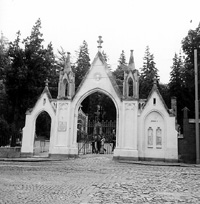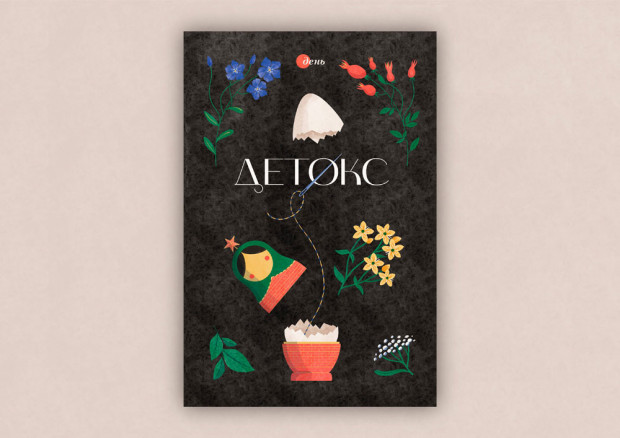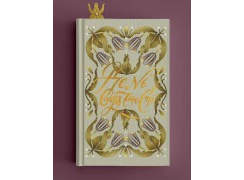Lychakiv Cemetery in Lviv

When the weather is bad and strong gusts of wing whistle through the cemetery one can hear the chains ring in the burial vault of Rozalia and Wanda Zamojski, mother and daughter who left no trace in local history except that both died a tragic death in 1902. Their vault is one of the most luxurious at the Lychakiv Cemetery in Lviv and they say that the lids of the coffins are made of crystal and one can see the bodies remaining absolutely untouched by time (there is a touch of pink to the cheeks of the deceased). There is another story connected with the vault which is told only on rare occasions: several decades ago men wearing militia uniforms opened the vault and took the bodies out to be buried elsewhere. The cemetery received its first residents in the early sixteenth century and its population had increased considerably over the centuries, yet no one at the time knew that the place would attract international attention as one of Europe's largest collection of precious necropolitan sculpture. Actually, it became Lviv's major cemetery in 1783 when the City Hall forbade burials at city churches. Even then legends existed, but they have sunk into oblivion.
In the mid-nineteenth century, the municipal authorities issued an order that was catastrophic for the ossuary's funereal stories in general and for modern history and culture in particular. The document ordered in the installation of a jackhammer at the Lychakiv Cemetery. This device was meant to crush statues and gravestones for paving cemetery paths. Moreover, the crushed stone was later used for the central cemetery gate and foundations of the fence circling the place. Graves, for which no one had paid the cemetery management for 25 years or had been left untended, were to be destroyed, their sites allocated for fresh graves. Because of this only a handful of gravestones dating back three hundred years have survived, including one bearing a legend in Armenian, dated 1675, and several others..
Incidentally, Lychakiv's distinctive feature is the presence of inscriptions on gravestones in different languages: Polish, German, Dutch, Romanian, and Greek. The oldest Ukrainian legend is on the gravestone of Denys Zubrytsky (1777-1862), a prominent Ukrainian scholar, historian, ethnographer, corresponding member of the St. Petersburg Academy of Sciences, one of the leaders of the Stavropihiysky Institute of Lviv.
Lviv's City Hall came up with yet another decree at the time. A talented local garden-planner by the name of Bauer laid out roads and walkways, along which trees were planted, transforming the cemetery into a cozy park. He also advised on how best to place the graves. It is interesting to note that ever since Lychakiv was proclaimed the main city cemetery the place would accommodate mostly people of means and rank: clergymen, army officers, prominent politicians, cultural figures, et al . This tradition was maintained until the Soviets came and then the cemetery was opened to the general public. From then on people would be buried anywhere, and it became just another standard graveyard with primitive uniform monuments made of concrete and crushed marble.
It took several decades to turn the Lychakiv Cemetery into an historical-cultural preserve, meaning that the place was once again closed to the dead without means or rank. This happened in November 1990 and the municipal authorities remembered old interments. For example, there is no coincidence about the presence in the main alley of the graves of absolutely uninteresting and practically unknown people like Francisco Zaremba and Anton Pjorecki alongside the places of the last repose of famous author Ivan Franko and singer Solomiya Krushelnytska; Markiyan Shashkevych, founder of modern Ukrainian literature in Halychyna, head of the Ruthenian Triad scholarly group; Vasyl Barvinsky, one of the leading composers of modern music, and other celebrated historical and cultural figures. And the reason is simple: Zaremba and Pjorecki were veterans of Tadeusz Kosciuszko's late eighteenth century Polish uprising and distinguished centenarians, one dying at 112 and the other at slightly under 106.
“In other words, burials were planned so one would find it interesting to stroll along the paths,” I was told by Andriy Huziy, a young local guide enraptured with Lychakiv and ready to talk about the place for hours on end.
Actually, the modern visitor is attracted by something different: buried here are people universally acclaimed in Ukraine — Volodymyr Ivasiuk, Olena Kulchytska, Ivan Krypiakevych, Iryna Vilde, Pavlo Kovzhun, Stanislav Liudkevych, Volodymyr Gzhytsky, Mykhailo Yatskiv, and hundreds of others in eternal sleep in the 42 hectares of the burial grounds, totaling some 300,000 graves, over 2,000 tombs, and at least 500 unique sculptures and bas reliefs.
Actually, these sculptures and reliefs as independent works of art would be an excellent addition to any park; they are something that preserves the inner magic of those who have left the world of the living. Some provoke understanding and legends. Appearing at Lychakiv in the late eighteenth century, thanks to sculptor Hartman Witwer, graduate of Vienna's Art Academy, these monuments tell of the deceased in the language of symbols and allegories. They are precisely what arouses the human imagination.
From the standpoint of mythical aura, the most powerful magnet in Lychakiv is the grave of Mykola Charnetsky, Ukrainian Greek Catholic Bishop, believed to have been a miracle worker. This year marks the fortieth anniversary of his death and every day the grave is visited by dozens of believers of different confessions, even atheists, hoping that his spirit will help them with their problems. Andriy Huziy told me that he had watched a woman bring her mortally afflicted daughter to the grave, and the girl was already big and heavy. Another woman took her overly mature bachelor son to the place, hoping that Mykola Charnetsky would inspire him to finally get married. Many people come here because they are convinced that Charnetsky helped their near and dear ones in times of ordeal. Young people also believe in his miraculous power even after his death. When the time comes for school or college examinations the cemetery workers have to tidy up the grave, adding earth, because every visitors leaves carrying a handful.
An arresting magnetism is emanated by the life- size statue of a sleeping young woman with hair spread over a pillow, the blanket moved to the side in her sleep. Several stories are associated with it. One has it that the woman's name was Barbara and that, already married, she fell in love with a young man. Eventually she found out he was cheating on her and poisoned herself. Another says that the talented sculptor Julian Markowski portrayed a young actress whose dramatic identification was so strong that she actually died when her heroine had to die on stage. The statue is damaged, as originally there was a stone angel at the head, standing, his face buried in his hands. Be it as it may, the statue never fails to attract Lychakiv visitors.
There is a sense of sad romanticism about the statue of artist Arthur Grotger (1837-67) commissioned by his sweetheart Wanda Monnet. Unattractive, devastated by consumption, he died in the French Pyrenees when he was thirty. His true love and he had not even the time to marry. Once, strolling through Lychakiv, Arthur had told her he would like to be buried here when his time came. She arranged for his remains to be transferred from a French cemetery to Lviv. Remarkably, the Italian architect, Paris Filippi, aware of the woman's passion, refused to be paid for his work. Even more remarkably, Wanda herself made her fiancО's portrait on the monument, amidst a variety of symbols. Later, she would marry and have a daughter, but people would often see her mournful figure, lost in grievous thought, by Arthur's grave. She would visit the place regularly, until her dying day. Lovers visiting the cemetery say they sometimes glimpse a young couple walking toward them, smiling, vanishing into thin air several yards from them. They believe the ghosts to be Arthur and Wanda come to greet other manifestations of true love.
“There is a grain of truth in every lie, and of lie in every truth,” Andriy Huziy summed up our excursion at the cemetery. “It's up to each of us to adopt the principles of our lives.”
Newspaper output №: Section






